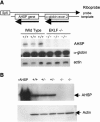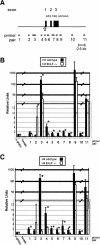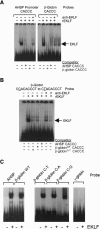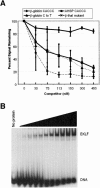Alterations in expression and chromatin configuration of the alpha hemoglobin-stabilizing protein gene in erythroid Kruppel-like factor-deficient mice
- PMID: 16705186
- PMCID: PMC1489081
- DOI: 10.1128/MCB.02216-05
Alterations in expression and chromatin configuration of the alpha hemoglobin-stabilizing protein gene in erythroid Kruppel-like factor-deficient mice
Abstract
Erythroid Krüppel-like factor (EKLF) is an erythroid zinc finger protein identified by its interaction with a CACCC sequence in the beta-globin promoter, where it establishes local chromatin structure permitting beta-globin gene transcription. We sought to identify other EKLF target genes and determine the chromatin status of these genes in the presence and absence of EKLF. We identified alpha hemoglobin-stabilizing protein (AHSP) by subtractive hybridization and demonstrated a 95 to 99.9% reduction in AHSP mRNA and the absence of AHSP in EKLF-deficient cells. Chromatin at the AHSP promoter from EKLF-deficient cells lacked a DNase I hypersensitive site and exhibited histone hypoacetylation across the locus compared to hyperacetylation of wild-type chromatin. Wild-type chromatin demonstrated a peak of EKLF binding over a promoter region CACCC box that differs from the EKLF consensus by a nucleotide. In mobility shift assays, the AHSP promoter CACCC site bound EKLF in a manner comparable to the beta-globin promoter CACCC site, indicating a broader recognition sequence for the EKLF consensus binding site. The AHSP promoter was transactivated by EKLF in K562 cells, which lack EKLF. These results support the hypothesis that EKLF acts as a transcription factor and a chromatin modulator for the AHSP and beta-globin genes and indicate that EKLF may play similar roles for other erythroid genes.
Figures








Similar articles
-
Genomic organisation and regulation of murine alpha haemoglobin stabilising protein by erythroid Kruppel-like factor.Br J Haematol. 2007 Jan;136(1):150-7. doi: 10.1111/j.1365-2141.2006.06381.x. Epub 2006 Oct 27. Br J Haematol. 2007. PMID: 17069580
-
Activation of the delta-globin gene by the beta-globin gene CACCC motif.Blood Cells Mol Dis. 1999 Jun-Aug;25(3-4):193-209. doi: 10.1006/bcmd.1999.0245. Blood Cells Mol Dis. 1999. PMID: 10575545
-
Activation of beta-globin promoter by erythroid Krüppel-like factor.Mol Cell Biol. 1998 Jan;18(1):102-9. doi: 10.1128/MCB.18.1.102. Mol Cell Biol. 1998. PMID: 9418858 Free PMC article.
-
Role of alpha-hemoglobin-stabilizing protein in normal erythropoiesis and beta-thalassemia.Ann N Y Acad Sci. 2005;1054:103-17. doi: 10.1196/annals.1345.013. Ann N Y Acad Sci. 2005. PMID: 16339656 Review.
-
Transcriptional factors for specific globin genes.Ann N Y Acad Sci. 1998 Jun 30;850:64-9. doi: 10.1111/j.1749-6632.1998.tb10463.x. Ann N Y Acad Sci. 1998. PMID: 9668528 Review.
Cited by
-
Regulation of delta-aminolevulinic acid dehydratase by krüppel-like factor 1.PLoS One. 2012;7(10):e46482. doi: 10.1371/journal.pone.0046482. Epub 2012 Oct 3. PLoS One. 2012. PMID: 23056320 Free PMC article.
-
Klf1 affects DNase II-alpha expression in the central macrophage of a fetal liver erythroblastic island: a non-cell-autonomous role in definitive erythropoiesis.Mol Cell Biol. 2011 Oct;31(19):4144-54. doi: 10.1128/MCB.05532-11. Epub 2011 Aug 1. Mol Cell Biol. 2011. PMID: 21807894 Free PMC article.
-
Detection and characterization of silencers and enhancer-blockers in the greater CFTR locus.Genome Res. 2008 Aug;18(8):1238-46. doi: 10.1101/gr.073817.107. Epub 2008 Apr 24. Genome Res. 2008. PMID: 18436892 Free PMC article.
-
Controlling hematopoiesis through sumoylation-dependent regulation of a GATA factor.Mol Cell. 2009 Dec 25;36(6):984-95. doi: 10.1016/j.molcel.2009.11.005. Mol Cell. 2009. PMID: 20064464 Free PMC article.
-
EKLF/KLF1, a tissue-restricted integrator of transcriptional control, chromatin remodeling, and lineage determination.Mol Cell Biol. 2013 Jan;33(1):4-13. doi: 10.1128/MCB.01058-12. Epub 2012 Oct 22. Mol Cell Biol. 2013. PMID: 23090966 Free PMC article. Review.
References
-
- Armstrong, J. A., J. J. Bieker, and B. M. Emerson. 1998. A SWI/SNF-related chromatin remodeling complex, E-RC1, is required for tissue-specific transcriptional regulation by EKLF in vitro. Cell 95:93-104. - PubMed
-
- Asano, H., X. S. Li, and G. Stamatoyannopoulos. 2000. FKLF-2: a novel Kruppel-like transcriptional factor that activates globin and other erythroid lineage genes. Blood 95:3578-3584. - PubMed
-
- Basu, P., T. G. Sargent, L. C. Redmond, J. C. Aisenberg, E. P. Kransdorf, S. Z. Wang, G. D. Ginder, and J. A. Lloyd. 2004. Evolutionary conservation of KLF transcription factors and functional conservation of human gamma-globin gene regulation in chicken. Genomics 84:311-319. - PubMed
Publication types
MeSH terms
Substances
Grants and funding
LinkOut - more resources
Full Text Sources
Molecular Biology Databases
Miscellaneous
